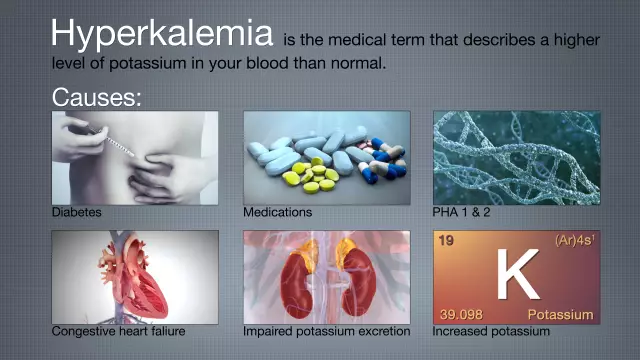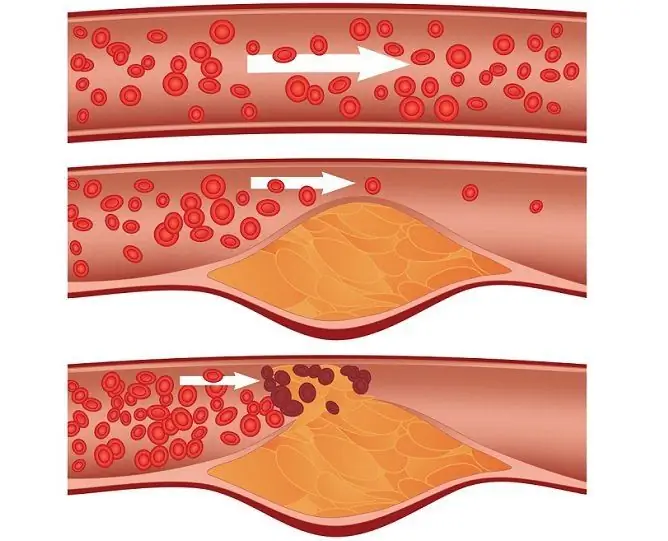- Author Rachel Wainwright [email protected].
- Public 2023-12-15 07:39.
- Last modified 2025-11-02 20:14.
Hyperkalemia

Hyperkalemia is a condition in which the concentration of potassium (K +) electrolytes in the blood rises to a level that is life-threatening. A patient with hyperkalemia requires urgent medical attention due to the potential risk of cardiac arrest if treatment is delayed.
The normal level of potassium in the blood is from 3.5 to 5.0 mEq / L, about 98% of potassium is contained within cells, and the remaining 2% is in the extracellular fluid, including in the blood.
Potassium is the most abundant intracellular cation, which is important for many physiological processes, including maintaining the resting membrane potential, cell volume homeostasis, and the transmission of action potentials in nerve cells. Its main food sources are vegetables (tomatoes and potatoes), fruits (oranges and bananas), and meat. The excretion of potassium occurs through the gastrointestinal tract, kidneys and sweat glands.
Hyperkalemia develops with excessive consumption or ineffective excretion of potassium. An increase in the extracellular level of potassium leads to depolarization of the membrane potential of cells due to an increase in the equilibrium potential of potassium. Depolarization leads to tension of sodium channels, opens them, and also increases their inactivation, which ultimately leads to ventricular fibrillation or asystole. Prevention of recurrence of hyperkalemia usually includes reducing the intake of dietary potassium and potassium-sparing diuretics.
Hyperkalemia symptoms
The symptoms of hyperkalemia are nonspecific and usually include:
- Malaise;
- The appearance of high T-waves on the ECG;
- Ventricular tachycardia;
- Muscle weakness;
- Increased ORS interval on the ECG;
- Increasing the PR interval on the ECG.
Also, symptoms of hyperkalemia are cardiac arrhythmia, a sharpening of the T wave on the ECG and an excess of potassium levels greater than 7.0 mmol / l.
Causes of hyperkalemia
The causes of hyperkalemia can be ineffective elimination of renal failure, Addison's disease and aldosterone deficiency. Also, the intake can lead to hyperkalemia:
- Angiotensin-converting enzyme inhibitors and angiotensin receptor blockers;
- Potassium-sparing diuretics (amiloride, spironolactone);
- Nonsteroidal anti-inflammatory drugs such as ibuprofen, naproxen, or celecoxib;
- Calcineurin inhibitors;
- Immunosuppressants (cyclosporine and tacrolimus);
- Antibiotics (trimethoprim);
- The antiparasitic drug pentamidine.
Also, the cause of hyperkalemia can be congenital hyperplasia of the adrenal cortex, Gordon's syndrome and renal tubular acidosis type IV.
Hyperkalemia can result from potassium supplements, potassium chloride infusions, and excessive consumption of potassium-containing salt.
Diagnosis of hyperkalemia
To collect sufficient information to diagnose hyperkalemia, it is necessary to constantly measure the level of potassium, because its elevated state may be associated with hemolysis in the first stage. Normal serum potassium levels are 3.5 to 5 mEq / L. Typically, diagnosis includes blood tests for kidney function (creatinine, blood urea nitrogen), glucose, and sometimes for creatine kinase and cortisol. Calculation of a trans-tubular potassium gradient sometimes helps in establishing the cause of hyperkalemia, and electrocardiography is performed to determine the risk of cardiac arrhythmias.
Hyperkalemia treatment

The choice of treatment depends on the degree and cause of hyperkalemia. When the potassium content in the blood exceeds 6.5 mmol / l, it is urgent to lower the potassium level to normal levels. This can be achieved by the administration of calcium (calcium chloride or calcium gluconate), which increases the threshold potential and restores the normal gradient between the threshold potential and the membrane resting potential, which increases with abnormal hyperkalemia. One ampoule of calcium chloride contains about three times more calcium than calcium gluconate. Calcium chloride begins to act in less than five minutes, and its effect lasts about 30-60 minutes. The dosage should be selected with constant monitoring of ECG changes during administration and the dose should be repeated if the ECG changes do not normalize within 3-5 minutes.
Also, to treat hyperkalemia and reduce the risk of complications, it is possible to carry out some medical procedures, which for some time help to suspend the process of hyperkalemia until potassium is removed from the body. These include:
- Intravenous administration of 10-15 units of insulin together with 50 ml of 50% dextrose solution to prevent hyperkalemia leads to the displacement of potassium ions into the cells. It lasts for several hours, so sometimes other measures need to be taken at the same time to suppress potassium levels on a more consistent basis. Insulin is usually given with an appropriate amount of glucose in order to prevent hypoglycemia after insulin administration;
- Bicarbonate therapy (infusion of 1 ampoule (50 meq) over 5 min) is an effective way to displace potassium into cells. Bicarbonate ions stimulate the exchange of H + for Na +, which leads to the stimulation of sodium-potassium ATPase;
- Introduction of salbutamol (albuterol, Ventolin), β 2-selective catecholamines 10-20 mg each. This drug also lowers K + levels by accelerating its movement into cells.
Treatment of severe hyperkalemia requires hemodialysis or hemofiltration, which are the fastest methods of removing potassium from the body. They are commonly used when the underlying cause of hyperkalemia cannot be quickly corrected or there is no response to other measures taken.
Sodium polystyrene sulfonate with sorbitol, orally or rectally, is widely used to reduce potassium within a few hours, and furosemide is used to excrete potassium in the urine.
YouTube video related to the article:
The information is generalized and provided for informational purposes only. At the first sign of illness, see your doctor. Self-medication is hazardous to health!






